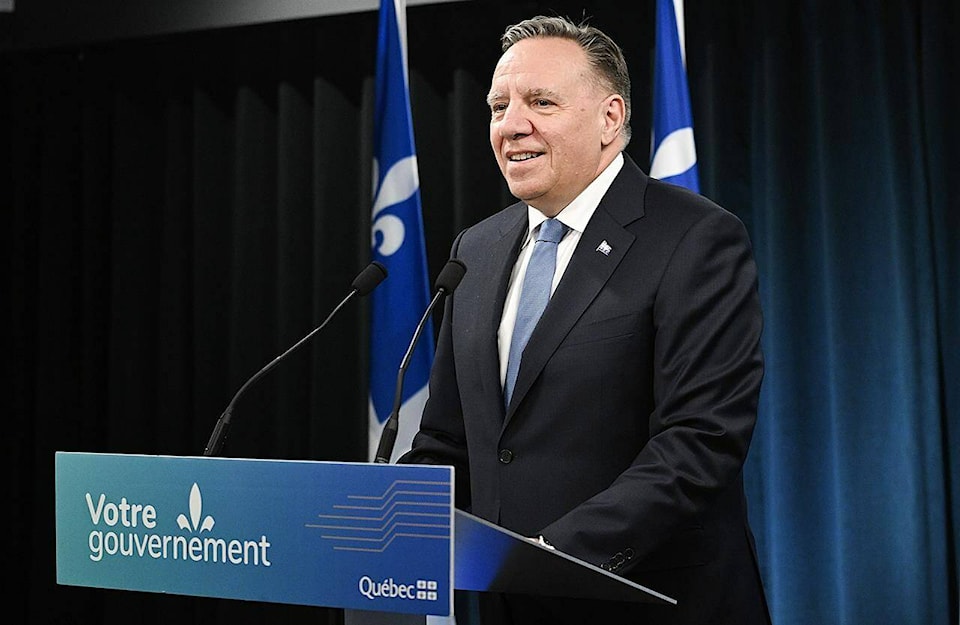Hours after Quebec’s highest court upheld his state secularism law, Premier François Legault was triumphant.
The decision was “a great victory for the nation of Quebec,” he said in a brief statement to reporters Thursday. And he would not shy away from using the Charter of Rights and Freedoms’ notwithstanding clause — which he now prefers to call the “parliamentary sovereignty clause” — to ensure Canada respects the choices of Quebecers, he promised.
But the Court of Appeal’s endorsement of the government’s use of the clause — which allows governments to override fundamental Charter rights — is sparking new debate about the place of the constitutional provision.
The use of the notwithstanding clause to shield the law, known as Bill 21, from court challenges was a key element of the Appeal Court decision, said Louis-Philippe Lampron, a Université Laval law professor. All the arguments put forward by the law’s opponents were about ways of getting around the clause, he said.
Lampron said the rebranding of the notwithstanding clause as the “parliamentary sovereignty clause” by the Legault government is “highly problematic.”
“It’s as if we aren’t talking about suspending fundamental rights,” he said. “Talking about parliamentary sovereignty seems to lessen the seriousness of this act, which puts determining the acceptable limits of fundamental rights solely in the hands of elected officials.”
The Appeal Court upheld almost every aspect of the law, which bans teachers, police officers, jail guards and judges from wearing religious symbols on the job, striking down an exemption for English school boards carved out by a lower court judge. Only a provision banning members of the province’s national assembly from wearing face coverings was judged unconstitutional.
Lampron said the ruling finds that the legal criteria for the use of the notwithstanding clause was settled by the Supreme Court of Canada in 1988 and the three Appeal Court judges didn’t find a reason to depart from the precedent.
If the case makes its way to the Supreme Court — as many who oppose the law hope it will — Lampron said the court will have to decide whether the “very, very, very unrestrictive” criteria for using the notwithstanding clause established in that 1988 ruling, known as Ford v. Quebec, remain pertinent in a sociopolitical climate that is very different, especially with regards to minority rights.
Since Quebec used the provision preemptively to shield Bill 21, it has done so again to shield a controversial language law reform. Saskatchewan used the provision last fall to protect a bill requiring parental consent when children under 16 want to change their name or the pronouns they use at school, while Ontario used it in 2021 and 2022.
Lampron said that for many years governments were hesitant to use the provision because they feared it would hurt them politically, but since the taboo was broken, it has being used more frequently.
In its ruling, the Appeal Court panel noted that the notwithstanding clause must be renewed every five years — ensuring there is an election between invocations — and that in 2022, Ontario repealed a law it had protected with the notwithstanding clause in the face of widespread public backlash.
Patrick Taillon, a law professor at Université Laval, said the ruling “is a technical, rational judgment that reminds us of the balance of powers and the compromises that were negotiated in our Constitution.”
Taillon said the clause is a compromise between the constitutional tradition of the United States and that of Britain, where Parliament is supreme.
The clause can be used to prevent judicial overreach, he said, if, for example, the Supreme Court changed its stance on medical assistance in dying or abortion.
Taillon said the limits on wearing religious symbols in the Quebec law only affect a small subset of civil servants. He presented the scenario of a police officer wearing a Muslim or Jewish symbol arresting someone wearing a symbol of the other faith at a political protest, saying the officer’s neutrality could be called into question.
“Bill 21 is a compromise that isn’t perfect, which isn’t supported unanimously, but which is the subject of a broad consensus,” he said.
For groups that challenged the law, the ruling was a disappointment.
“I think it’s important for everybody that we take note of the devastating impact the notwithstanding clause has when it’s used by a government to violate the rights of marginalized communities in a particular location,” said Noa Mendelsohn Aviv, the executive director of the Canadian Civil Liberties Association.
Mendelsohn Aviv said that while there were a number of reasons the clause was included by drafters of the Constitution — “it was never meant as anything other than a last resort. We don’t think it’s a legitimate use of the notwithstanding clause to use it to violate fundamental rights of minorities.”
But for supporters of the religious symbols ban, the decision was a victory for democracy.
“The Court of Appeal is explicitly saying that this is about democracy, that the notwithstanding clause is not something that violates rights, it’s not something that goes against democracy,” said Guillaume Rousseau, a lawyer for Mouvement laïque québécois, a group that intervened in the case to support the government. “It’s part of our democracy and it’s up to the elected officials to decide.”
Jacob Serebrin, The Canadian Press



